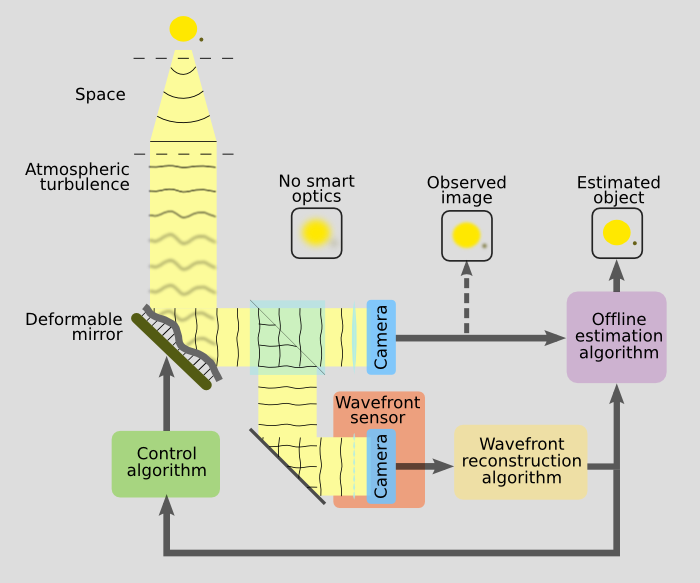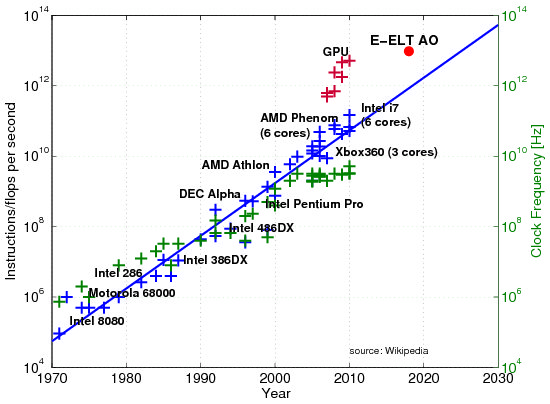Fast and high performance adaptive optics for the E-ELT
Part of Dutch Consortium for E-ELT Instrumentation
Funding: 9M€ by NWO/NOVA (The Netherlands Research School for Astronomy)
| Applicants: |
Prof. Michel Verhaegen (TU Delft, project leader) Dr. ir. Rufus Fraanje (TU Delft) |
| Partners: |
Prof. Christoph Keller (University of Leiden) Dr. Niek Doelman (TNO) |
| Researcher: | PhD/PostDoc vacancy |
Complexity of adaptive optics for ELT's
The large diameter of extremely large telescopes (ELTs) will enable high angular resolution (<10mas in the near-infrared, 1mas = 1 milli arcsecond ≈4.8⋅109rad) and high contrast astronomical observation necessary for detection of small (earthlike) exoplanets and deep space observation to study the history of the universe. For example with the 42m diameter European-ELT (E-ELT) the diffraction limit of 1μm wavelengths is only 6mas. However, this diffraction limit will not be achievable without large scale adaptive optics (AO) to compensate for distortions due to (multilayer) atmospheric turbulence, wind forces, (ground) vibrations, temperature variations, and optical alignment errors. In the design of ELTs it is obtained to reduce the influence of these disturbances as much as possible, by proper site selection, active and passive isolation from wind forces and vibrations, temperature stable optomechanic design, etc. But, these distortions can never be completely canceled in (cost effective) ELT design.

In the presence of atmospheric turbulence with a coherence length r0 (also known as Fried parameter), the maximum resolution that can be achieved is given by 1.22λ/min(D,r_0), where λ the wavelength and D the telescope diameter. Under good observation conditions the coherence length is about r0=20cm, such that the resolution at λ=1μm waves obtained by the E-ELT will be only 1.3arcsecond, which is a factor D/r0=210 higher than the diffraction limit. To fully compensate for these distortions, i.e., atmospheric turbulence but also other distortions such as vibrations and temperature changes, deformable mirrors (DMs) and wave front sensors (WFSs) with inter-actuator/-sensor distance in the order of r0 are necessary, such that the number of actuator/sensor channels will be in the order of (D/r0)2=44100. Roughly speaking the number of channels scales with the square of the improvement in resolution.
The computational complexity of the on-line operation and off-line synthesis of current state of the art PI (Proportional-Integral) and LQG (Linear Quadratic Gaussian) controllers scales at least with the square and the cube of the number of channels. For example, consider again the E-ELT with 44100 channels, then the computational load of a PI controller running at 2kHz is already 7.8Tflops (1flops = 1 floating point operation per second). Current field programmable gate array (FPGA) technology enables peak-performances of 10-100Gflops, such that the matrix multiplication need to be distributed over about 100 FPGAs, which seems to overly complicate the controller implementation and will not be cost effective and result in (relatively) high power dissipation.

Development of computing power in time based on specification of computing power and clock frequency of state of the art CPU's (source: wikipedia)
Project goal and approach
The goal of the project is to demonstrate control of adaptive optics systems relevant for the E-ELT and its instruments using off-the shelf multi-core hardware (GPU's and/or multi-core CPU's).
The approach is as follows:
- Comparison of various algorithms (Kolmogorov model-based and model-free such as FFT reconstrution) will be made, in terms of performance versus complexity and parallelism.
- Optimization of the computational complexity versus performance trade-off. Structure in the correlation of the turbulence will be exploited to improve the complexity versus performance trade-off.
- Investigation and selection of various off-the shelf multi-core hardware will be made.
- Implementation on multi-core hardware.
- Real-time validation, demonstrating an AO platform scalable to a natural guide star AO system with 40.000 actuators with a read-out time of 0.3ms.
Project status
- MSc student Wimar Klop has investigated FPGA, GPU and
multi-core CPU controllers in a literature study, and developed a
distributed reconstruction algorithm during his MSc project.
- W. Klop, E-ELT under control - Adaptive optics low-level control solutions for E-ELT, Literature Survey, Delft University of Technology, May 26, 2011. [PDF]
- W. Klop, Development of an efficient parallel wavefront reconstructor - with implementation on a GPU, Delft University of Technology, Jun 28, 2011. [PDF]